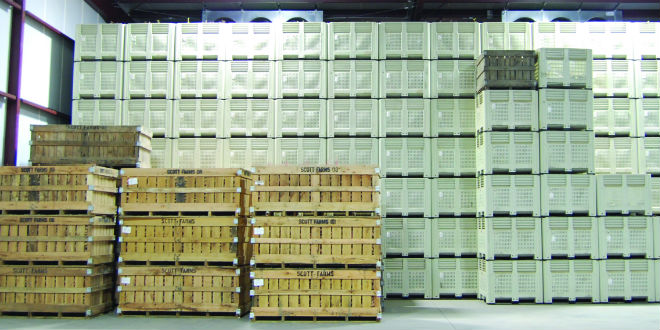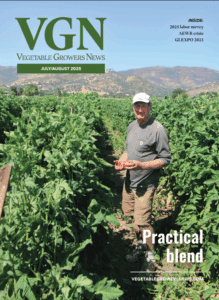Jun 24, 2016Storage techniques transform vegetable industry
Cooling has been central to the idea of food preservation almost as long as civilization has been around. Evidence for cooling by evaporation or storing in caves goes back thousands of years. Ice houses were used more than 4,000 years ago in Mesopotamia and 3,000 years ago in China, according to Randy Beaudry, a professor and storage specialist with Michigan State University (MSU).
More recently, the United States was shipping ice from its lakes and rivers around the world, until the mechanical refrigeration industry grew to the point where ice could be made at the point of usage. The more-or-less modern compressor refrigeration systems were invented in the 1870s by Carle von Linde, and suddenly there was ice and refrigeration everywhere, according to Beaudry.
By the 1910s, high-value agricultural industries like meat were using refrigeration, and fruit and vegetable storage probably followed soon after. Electrification helped spread refrigeration into rural communities in the 1930s, he said.
Vegetable growers and others were quick to realize that hydrocooling and forced-air cooling removed heat more rapidly than simple refrigeration. Eventually, vacuum cooling (boiling the water out of the harvested vegetables, mostly used on leafy greens) was developed. These coolers used to be shipped from one production area to another as the season progressed, Beaudry said.
In the past half-century, the use of controlled atmosphere (CA) storage became a staple of the produce industry. Using CA, perishable fruits and vegetables are stored under narrowly defined environmental conditions, allowing growers and packers to extend their seasons and better meet demand, according to a 2011 interview with David Dilley, an MSU professor and postharvest specialist (Dilley died in 2015).
Beaudry said CA storage of cabbage and onions was common by the 1980s and ’90s, along with the drying of bulbs and curing of sweet potatoes.
Packaging also has played a large role in produce storage. The British came up with polyethylene, the modern packaging film, during World War II. They kept it a state secret for a number of years, after inventing it as an insulator for transatlantic cables. The plastic has many uses now, including as one of the primary packaging materials for fresh fruits and vegetables, Beaudry said.
In the last 50 years, modified atmosphere packaging has come into its own. The fresh-cut lettuce industry takes advantage of modified atmospheres to prevent browning of cut surfaces. The low oxygen in the packages prevents the oxidation reactions that lead to browning, and so preserves visual quality. Most of the lettuce in restaurants and foodservice institutions throughout the country use this technology for preserving lettuce quality, Beaudry said.
There have been many advances over the last few decades, but refrigeration has made the biggest difference in the industry’s ability to store produce. Packaging technologies can only work with good refrigeration at every link of the chain – from the farm to the storage to the processing plant to the distribution center to the retail center to the home. The United States leads the world in the development of this unbroken cold chain. Combined with its modern transportation networks, the country is a preferred destination for crops from all over the world. U.S. consumers today can have just about any produce they want at any time, Beaudry said.
Sweet potatoes
To Mike Boyette, there’s no better example of how storage can change an industry than North Carolina sweet potatoes.
According to Boyette, a professor and ag engineer with North Carolina State University (NCSU), sweet potatoes were considered a regional, seasonal crop for a long time. People ate them at Thanksgiving and Christmas, and that’s about it.
Which was fine, because up until about the 1940s, sweet potato storage was very primitive: usually a hole in the ground, covered with straw or soil, he said.

After World War II, North Carolina started marketing its sweet potatoes further north. The state was competing with Louisiana, which has an earlier harvest. Because the price of sweet potatoes went up every January (even though demand went down), North Carolina growers decided there was money to be made if they could store their product for a longer period and sell it later (the state’s harvest peaks in September and October), Boyette said.
By the 1950s, attempts were being made to build storage facilities, but knowledge of how to properly store sweet potatoes was still limited. When first harvested, sweet potato skins are very delicate and easy to damage (the main reason most aren’t machine harvested). For that reason, as well as to improve its flavor, the crop needs to be cured for about a week, he said.
After a lot of trial and error, the industry learned the proper temperature and humidity treatments needed to store sweet potatoes for long periods and maintain their quality. Producers started building curing and storage facilities with more sophisticated temperature, humidity and airflow controls. Shortly after Boyette joined the industry in the 1980s, growers started adopting horizontal ventilation, a technique he had observed with forced-air cooling in California. It worked so well that more and more growers adopted it, he said.
North Carolina currently has horizontal-ventilation facilities that can store 25 million to 30 million bushels of sweet potatoes – more than 95 percent of the national capacity, Boyette said.
Packout rates (the amount sold compared to the amount harvested and put in storage) also have improved. In the ’60s and ’70s, North Carolina growers had been happy with a 65 percent packout rate. Today, the rate is as high as 95 percent. Correctly cured and stored, some sweet potatoes can last as long as 14 months in storage, he said.
“Hundreds of millions of dollars have been invested in horizontal-ventilation sweet potato storage in North Carolina in the last 25 years,” Boyette said. “It’s really turned our industry around, from regional to global.”
Because North Carolina could store its sweet potatoes for so long, it started “gobbling up market share all over the place.” Grocery chains and restaurants started buying the crop year round. With help from the NCSU-developed Covington variety, North Carolina is now the No. 1 producer in the country, producing about 60 percent of the nation’s sweet potatoes, he said.
There are about a dozen large packing facilities in the state today, along with several dozen smaller ones. Big food processors have discovered sweet potatoes, too, and set up their own facilities in the state, Boyette said.
“They wouldn’t be here if they weren’t guaranteed a year- round product.”
— Matt Milkovich, managing editor

















